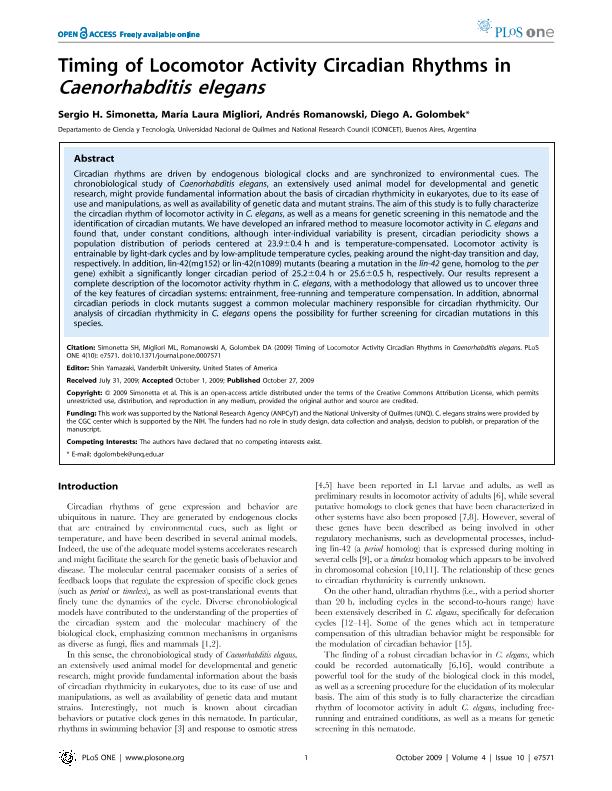Mostrar el registro sencillo del ítem
dc.contributor.author
Simonetta, Sergio Hernan

dc.contributor.author
Migliori, María Laura

dc.contributor.author
Romanowski, Andrés

dc.contributor.author
Golombek, Diego Andrés

dc.date.available
2017-09-28T20:58:48Z
dc.date.issued
2009-10
dc.identifier.citation
Simonetta, Sergio Hernan; Migliori, María Laura; Romanowski, Andrés; Golombek, Diego Andrés; Timing of locomotor activity circadian rhythms in Caenorhabditis elegans; Public Library of Science; Plos One; 4; 10; 10-2009; 1-8; e7571
dc.identifier.issn
1932-6203
dc.identifier.uri
http://hdl.handle.net/11336/25391
dc.description.abstract
Circadian rhythms are driven by endogenous biological clocks and are synchronized to environmental cues. The chronobiological study of Caenorhabditis elegans, an extensively used animal model for developmental and genetic research, might provide fundamental information about the basis of circadian rhythmicity in eukaryotes, due to its ease of use and manipulations, as well as availability of genetic data and mutant strains. The aim of this study is to fully characterize the circadian rhythm of locomotor activity in C. elegans, as well as a means for genetic screening in this nematode and the identification of circadian mutants. We have developed an infrared method to measure locomotor activity in C. elegans and found that, under constant conditions, although inter-individual variability is present, circadian periodicity shows a population distribution of periods centered at 23.960.4 h and is temperature-compensated. Locomotor activity is entrainable by light-dark cycles and by low-amplitude temperature cycles, peaking around the night-day transition and day, respectively. In addition, lin-42(mg152) or lin-42(n1089) mutants (bearing a mutation in the lin-42 gene, homolog to the per gene) exhibit a significantly longer circadian period of 25.260.4 h or 25.660.5 h, respectively. Our results represent a complete description of the locomotor activity rhythm in C. elegans, with a methodology that allowed us to uncover three of the key features of circadian systems: entrainment, free-running and temperature compensation. In addition, abnormal circadian periods in clock mutants suggest a common molecular machinery responsible for circadian rhythmicity. Our analysis of circadian rhythmicity in C. elegans opens the possibility for further screening for circadian mutations in this species.
dc.format
application/pdf
dc.language.iso
eng
dc.publisher
Public Library of Science

dc.rights
info:eu-repo/semantics/openAccess
dc.rights.uri
https://creativecommons.org/licenses/by/2.5/ar/
dc.subject
C. Elegans
dc.subject
Circadian Rhythms
dc.subject
Locomotor Activity
dc.subject.classification
Bioquímica y Biología Molecular

dc.subject.classification
Ciencias Biológicas

dc.subject.classification
CIENCIAS NATURALES Y EXACTAS

dc.title
Timing of locomotor activity circadian rhythms in Caenorhabditis elegans
dc.type
info:eu-repo/semantics/article
dc.type
info:ar-repo/semantics/artículo
dc.type
info:eu-repo/semantics/publishedVersion
dc.date.updated
2017-09-28T18:14:53Z
dc.journal.volume
4
dc.journal.number
10
dc.journal.pagination
1-8; e7571
dc.journal.pais
Estados Unidos

dc.journal.ciudad
San Francisco
dc.description.fil
Fil: Simonetta, Sergio Hernan. Universidad Nacional de Quilmes. Departamento de Ciencia y Tecnología; Argentina. Consejo Nacional de Investigaciones Científicas y Técnicas; Argentina
dc.description.fil
Fil: Migliori, María Laura. Universidad Nacional de Quilmes. Departamento de Ciencia y Tecnología; Argentina. Consejo Nacional de Investigaciones Científicas y Técnicas; Argentina
dc.description.fil
Fil: Romanowski, Andrés. Universidad Nacional de Quilmes. Departamento de Ciencia y Tecnología; Argentina. Consejo Nacional de Investigaciones Científicas y Técnicas; Argentina
dc.description.fil
Fil: Golombek, Diego Andrés. Universidad Nacional de Quilmes. Departamento de Ciencia y Tecnología; Argentina. Consejo Nacional de Investigaciones Científicas y Técnicas; Argentina
dc.journal.title
Plos One

dc.relation.alternativeid
info:eu-repo/semantics/altIdentifier/url/http://journals.plos.org/plosone/article?id=10.1371/journal.pone.0007571
dc.relation.alternativeid
info:eu-repo/semantics/altIdentifier/doi/http://dx.doi.org/10.1371/journal.pone.0007571
Archivos asociados
